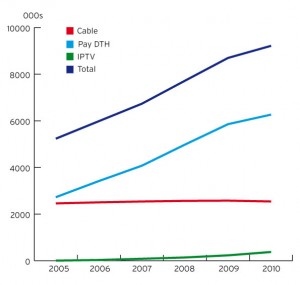Momentum in the Middle East – The region and its growth prospects
While nascent TV markets like the Middle East and Africa are by their very nature subject to significant and rapid change, the past couple of years have been particularly dramatic, writes Informa Telecoms & Media’s media research manager Adam Thomas.
A trio of pay TV operators – Orbit Communications, Arab Radio & Television (ART) and Showtime Arabia – had dominated the Middle East pay TV sector since the mid-1990s. But the merging of Showtime and Orbit to create the Orbit Showtime Network (OSN) is an ambitious attempt to take pay TV to the mass market by moving beyond the affluent demographics that have been targeted to date.
Since the creation of OSN there have also been significant changes at ART – it having sold or licensed off much of its premium Arabic entertainment and sports content. This leaves OSN as the region’s undisputed ‘full service’ pay TV leader.
But it would be an oversimplification to call OSN ‘dominant’. Al Jazeera Sports (AJS) and Abu Dhabi Media Company (ADMC) have invested heavily in acquiring premium sports content for their pay TV bouquets. With sport, particularly soccer, the most attractive genre for local audiences, this makes them significant players too.
New research from Informa Telecoms & Media has found that there were 79.9 million TV households in the Middle East and North Africa (MENA) region at end-2010. Satellite TV dominates, being the primary TV service in 65% of MENA TV households. Some homes, particularly in Gulf States, either have two dishes or a dual LNB (amplifier) to take signals from two satellites.
With satellite so dominant (fig. 1), there has been limited cable and IPTV activity, although IPTV, in particular, is growing fairly quickly, albeit from a very low base. Despite some signs of progress, broadband penetration in the region remains low. IPTV is therefore restricted from even greater progress, both by this lack of broadband penetration and also by the fact that where broadband is in place it is not always suitably robust to facilitate IPTV provision.
Legislative/regulatory issues continue to pose difficulties for the TV sector. The close relationship between the state and many broadcasters is often seen as having an inhibiting effect, although the pro-democracy ‘Arab Spring’ movement may help to loosen these ties a little. Some media legislation meanwhile is out-of-date and often unable to deal with recent developments such as digital TV, the internet, mobile TV and IPTV. A major positive for the region is that the youthful demographic skew in many countries minimises barriers to the acceptance of new technologies. This mindset will help promote demand for important concepts such as convergence and technological upgrading.
Where the broadband infrastructure allows it, over-the-top (OTT) video services are gathering momentum, tapping into the fact that the young tend to spend more of their disposable income on new communication types, so giving these services a good chance of success. Such offerings will also benefit from the strong brands present in the region and a good deal of brand-led convergence into these new areas is anticipated.
In comparison to a start-up business, a brand already strong in one area of the media will find it relatively easier to export that brand into a new media area. Increasingly, companies established in traditional media areas will see themselves being pushed into brand diversification by demand from the growing youthful demographic.
In the longer term, however, OTT does have the potential to disrupt pay TV growth, particularly considering the dominance of a youthful demographic that has grown up without pay TV – so perceiving OTT as the ‘norm’. Pay TV companies are already reacting with TV Everywhere initiatives, which seems sensible.
Looking at content genres, the pay TV staples of sport and films are important but in this often strife-torn region news is also important. There is keen interest region-wide in the latest happenings in Iraq, Iran and Israel/Palestine and what the impact of developments in those countries may have on their own country.
The rise of devoted media zones, such as the Dubai Media City, and others in Jordan, Syria and Egypt, are improving production values in the region. This will also improve the future prospects for the sector, as better quality TV, both in terms of technology and content, can only have a positive impact.
As mentioned above, long-anticipated consolidation amongst the main pay TV platforms finally took place in 2009, with Orbit and Showtime combining to create OSN, in a deal which should benefit from adding Showtime’s Hollywood content deals to Orbit’s strength in local programming. OSN has also since added a suite of attractive entertainment channels from ART – so further expanding its Arabic-language offering.
But the most significant omission from OSN’s line-up is the most sought after sports content. Much of this has been acquired by AJS and ADMC, with their state-backed operations having the financial muscle to outbid OSN, even if the business case for doing so is not there.
This type of vanity operation has been a recurring theme in the region and while the creation of OSN is a move towards a commercially-run sector, these services still exist.
The difficulty is that operations with a non-commercial objective compromise those with commercial strategies, as they have high costs but less compunction to make a profit. They have lavish budgets but little chance of becoming financially self-sufficient. There are no signs of the non-commercial services being closed by their backers – putting the likes of OSN on the back foot in content auctions.
Informa’s research (fig. 2) shows that region-wide there were 9.2 million MENA pay TV households at end-2010 – giving a pay TV penetration rate of 14% of TV households. Turkey and Israel account for 5.6 million of these homes, 60% of the total. Informa forecasts that the region will have 13.7 million pay TV subs by end-2016, an 18% penetration rate.
Turkey’s Digiturk is the MENA region’s largest pay TV operator. Outside of Turkey and Israel, OSN is the largest full service supplier with half a million subscribers – although the AJS bouquet has more than a million subscribers. Other significant players include ART, although its subscriber base has been in decline, plus Etisalat’s operations in the UAE.
Canal Plus Overseas had added a North African dimension to its sub-Saharan pay TV service, but it failed to find an audience and was wound down in the second half of 2011.
TV advertising runs at about US$5 (€3.65) per capita in the MENA region compared with US$100 in western Europe. Although the Middle East is unlikely to reach European levels in the foreseeable future, there is plenty of growth potential.
However, TV advertising is not growing as fast as the number of channels available, especially free-to-air ones. There were more than 500 free-to-air satellite channels as of the second half of 2011, up from just 100 in January 2004, although the signs are that the rate of growth is slowing.
The major players feel obliged to launch thematic free-to-air channels as their core services come under threat from audience fragmentation. With so many free-to-air channels on offer, the incentive to subscribe to a pay platform diminishes.
So, while there are several positive factors emerging in the region’s TV sector, the composition of the free-to-air market can still create something of a vicious circle: too many choices means lower average reach per channel, followed by decreasing average ad revenues. Higher programming costs and decreasing revenues means greater losses, which leads to lower quality programming that again decreases average reach.



